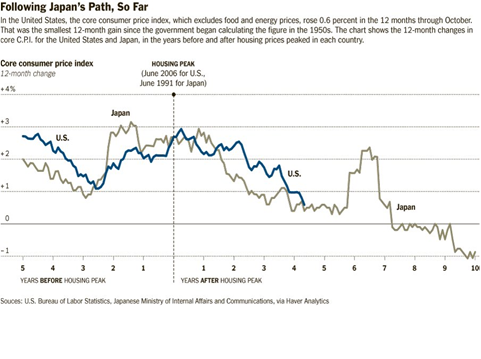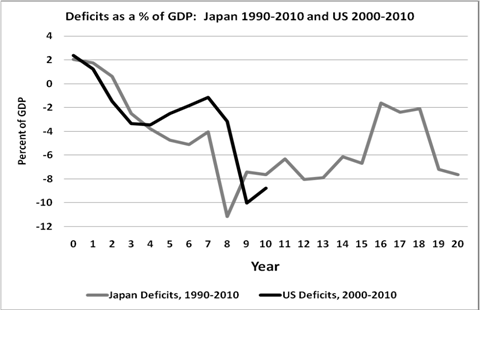The most theoclassical economists are often non-economists like Peter Wallison. His bio emphasizes the passion that has consumed his adult life.
From June 1981 to January 1985, he was general counsel of the United States Treasury Department, where he had a significant role in the development of the Reagan administration’s proposals for deregulation in the financial services industry….
[He] is co-director of American Enterprise Institute’s (“AEI”) program on financial market deregulation.
Wallison is back in the media because the Republican Congressional leadership appointed him to the Financial Crisis Inquiry Commission. The Commission has four Republicans and six Democrats. Three of the Republicans were architects of the financial deregulation policies that made possible the current crisis. The fourth, Bill Thomas, was an ardent Congressional supporter of those policies that helped make those policies law. Unsurprisingly, none of the Republicans is willing to support the findings of the Commission’s staff’s investigations of the causes of the crisis because deregulation, desupervison, and de facto deregulation (the three “des”) played a decisive role in making the crisis possible. Each of the Republican members of the Commission is in the impossible position of being asked to investigate his own policies, which the Commission’s investigations have shown to have had disastrous consequences.
Even within the Republicans, however, Wallison stands out for the zeal of his efforts to blame everything on the government and working class Americans. He decided that his Republican colleagues had been too weak in condemning the staff’s findings and wrote a separate, lengthy dissent to make his case. Wallison’s actions were predictable. He was famous prior to his appointment for creating the narrative that the government’s desire to help working class Americans purchase homes twisted Fannie and Freddie into the Great Satans that caused the crisis. He believes in complete deregulation – banks deposits should not be insured by the public and banks should not be regulated.
I have critiqued Wallison’s claims about the current crisis and explained why I think he errs. I will return to this task in future columns now that he has written a lengthy dissent. In this column I will discuss a portion of a shorter, even more revealing article that he wrote that exemplifies what I will argue are the consistent defects introduced by his anti-regulatory dogma in each of his apologies for a series of financial deregulatory disasters over the last 30 years.
Wallison wrote an article in Spring 2007 (“Banking Regulation’s Illusive Quest”) criticizing a conservative law and economics scholar, Jonathan Macey, who had written an article about financial regulation. Wallison was disappointed that Macey, who typically opposes regulation, concluded that banking regulation was necessary. Wallison wrote the article to rebut Macey. I’ll discuss only the portion of Wallison’s article that seeks to defend S&L deregulation.
Wallison begins his critique of Macey by asserting:
If the business of banking is inherently unstable, it would long ago have been supplanted by a stable structure that performs the same functions without instability.
Why? That assumes that there are banking systems that are inherently stable and that the market will inherently establish such systems. There is nothing in logic or economic history that requires either conclusion. Economic theory predicts the opposite. Indeed, the paradox of stability producing instability was Hyman Minsky’s central finding.
Wallison does not support his assertion. The accuracy of the assertion is critical to Wallison’s embrace of financial deregulation. If banks are inherently stable, then financial regulation is unnecessary. He assumes that which is essential to his conclusion. His closest approach to reasoning is circular and unsupported.
In the absence of regulation or deposit insurance, one would expect to see banks hold sufficient capital for this purpose, simply because instability would result without it and instability would make it difficult for banks to acquire deposits.
So, absent regulation and deposit insurance, bank instability cannot exist because instability would make banks unstable. Banks would want to be stable, so Wallison “expects” that they would hold “sufficient capital.” His “expectation” is his conclusion. One does not prove one’s conclusions by “expect[ing]” that they are true.
Wallison cited his (then) co-director of AEI’s deregulatory program, Charles Calomiris, who argued that early U.S. banks with broad branching authority had low failure rates. The study design could not prove Wallison’s argument about private market discipline. Mr. Calomiris’ attempt to employ his theories in the real world led to the failure in 2009 of the S&L he controlled. His brother, George, tried unsuccessfully to get Charles removed from his control of the S&L:
In 2004, after the company posted large losses, George Calomiris asked the board to replace Charles Calomiris and Amos with “qualified, experienced management,” he said in a letter to the board.
That request fell on deaf ears, George Calomiris said in an interview. “Since that time, I and everyone else who protested my brother’s total incapacity to do anything in the real world have seen the truth. … It’s been a total disaster.”
He said he has lost more than $1 million he invested in the bank. “This is not sour grapes. I’m not the only guy who has lost a fortune here.”
While calling his brother an esteemed professor, George Calomiris said “he hasn’t any idea how to run a bank.”
Several local banking experts and investors shared that sentiment, but declined to go on the record.
And that really is the central point of why Wallison, Calomiris, and AEI’s financial deregulatory efforts have caused so much harm to America. AEI’s financial deregulation efforts have been immensely influential even though they were run by individuals who had a “total incapacity to do anything” successful “in the real world.” Accounting and fraud happen in the real world and they turn these anti-regulatory dogmas into “a total disaster.” Indeed, they turn them into recurrent, intensifying disasters. That is why Tom Frank’s famous book title: “The Wrecking Crew” describes Wallison so well. He has led the financial wrecking crew. As his track record of failure has increased, so has his refusal to accept personal responsibility for those failures.
The dynamic Wallison relies upon, private market discipline, cannot be “expect[ed]” to be reliable. Even if we assumed that creditor and shareholders act in accordance with the rational actor model that Wallison implicitly relies upon (and economists and psychologists have proven that assumption is unreliable) it would not follow that private market discipline would be effective to make banks stable.
Private market discipline becomes harmful – not simply ineffective – in four common circumstances even if actors are purely rational. First, if creditors and shareholders believe they can rely on the bank having “sufficient capital” then control frauds will use accounting fraud to create fictional bank capital so that they can defraud the creditors and shareholders.
Second, given the risks of accounting control fraud to creditors and shareholders, creditors and shareholders will realize that reported net worth may be a lie. That uncertainty means that the creditors and shareholders may not be willing to lend to and invest in banks that are actually solvent. Indeed, the depositors may stage a run on a healthy bank. Capital does not save banks from serious runs.
Third, when the bank is an accounting control fraud its senior officers will use their ability to hire, fire, promote, and compensate to create perverse incentives that suborn its employees and internal and external controls (the appraisers, auditors, and credit rating agencies) and turn them into fraud allies. The perverse incentives create a “Gresham’s” dynamic in which bad ethics drives good ethics out of the marketplace. This produces what white-collar criminologists refer to as “echo” epidemics of fraud.
Fourth, banks engaged in accounting control fraud can generate Gresham’s dynamics and produce “echo” epidemics of fraud in “upstream” providers of loans. Bank control frauds create pay systems for loan brokers, and loan products, i.e., “liar’s” loans, that produce such intensely perverse financial incentives that they are intensely criminogenic. This produced endemic fraud in liar’s loans obtained by loan brokers.
Note that these failures demonstrate that deposit insurance does not end private market discipline. Fraudulent CEOs systematically pervert market incentives and use their power as purchasers and their ability to massively inflate reported income and capital to exert discipline and produce perverse behavior. Indeed, they create an environment so perverse that it becomes criminogenic.
Famous economists, Akerlof & Romer 1993 (“Looting: the Economic Underworld of Bankruptcy for Profit), the National Commission on Financial Institution Reform, Recovery and Enforcement (NCFIRRE) 1993 (which investigated the causes of the S&L debacle) and many of the nation’s top white-collar criminologists, Calavita, Pontell & Tillman 1997 (Big Money Crime), and a number of my works had explained how accounting fraud worked many years before Wallison wrote this article.
Wallison relies on the same circularity when he turns explicitly to the S&L debacle.
Because they were backed by the government, the s&ls were not required to hold capital that was commensurate with the risk they were taking, and depositors and other creditors were not concerned about this risk for the same reason.
His first clause merely asserts that the S&Ls would have been required to hold more capital absent deposit insurance. His second clause is even weaker. Why do “other creditors” – uninsured creditors at risk of suffering severe losses upon the failure of the S&L – should have exercised effective market discipline against the S&Ls. They never did so. Many S&Ls had subordinated debt. Anti-regulatory proponents like Wallison assert that subordinated debt provides superb private market discipline against banks. The purchasers of sub debt are not insured, they are supposed to be financially sophisticated, and they often buy large amounts of sub debt – all factors that are supposed to optimize private market discipline. The problem is that they have consistently failed to do so in reality. Deeply insolvent S&Ls were able to issue sub debt.
Neither Macey nor Wallison address the consistent failure of uninsured S&L creditors and shareholders – a failure that destroys their underlying assumption that deposit insurance is the cause of market discipline failures. But recall that Macey and Wallison were writing well after the S&L debacle. They were writing after the failure of the Enron-era accounting control frauds – frauds at firms that had no deposit insurance. Market discipline becomes an oxymoron in the presence of accounting control fraud. As Akerlof & Romer (1993) stressed, fraud is a “sure thing.” Creditors rush to lend to uninsured non-financial firms that report record (albeit fictional) income. The control frauds loot the creditors and shareholders. Despite having seen “private market discipline” fund rather than discipline hundreds of huge frauds, Macey and Wallison simply assumed that private market discipline would succeed absent deposit insurance.
Macey writes, “Without government regulation to substitute for the market discipline typically supplied by contractual fixed claimants, disaster ensued.” True enough, but regulation was clearly the underlying cause of the problem.
Wallison’s description of S&L deregulation is remarkably selective and disingenuous.
The deregulation that occurred was an effort to compensate for the earlier regulatory mistakes, but it was too late. Many in the industry were already hopelessly insolvent.
Deregulation was an expedient that came too late to halt the slide of the s&l industry toward insolvency.
And allowing undercapitalized or insolvent s&ls to continue to function — attracting deposits through use of their government insurance — guaranteed a financial catastrophe.
Only the last assertion is sound, but Wallison misinterprets even it, for it was a product of the deregulation that his department (Treasury) imposed on the Federal Home Loan Bank Board. Relatively few S&L were “hopelessly insolvent” as a result of the interest rate increases of 1979-82. NCFIRRE’s estimate is that $25 billion (of the $150 billion in total, present value cost ($1993) of resolving the debacle) was caused by interest rate increases. Interest rates began to fall later in 1982 and generally continued to fall. The great bulk of S&L failures – and the overwhelming bulk of the cost of resolving those failures – was caused by credit losses. Accounting control fraud was a major cause of those costs.
Wallison, understandably, focuses on the most benign aspects of S&L deregulation. Federally chartered S&L were permitted to issue adjustable rate mortgages (ARMs) and S&Ls were permitted to pay depositors higher interest rates. (S&L regulators had long supported both of those changes. Congress was the problem.) I quoted above from Wallison’s bio to show his emphasis on his leadership role in framing the Reagan administration’s financial deregulation.
The deregulation, desupervision, and de facto decriminalization of the S&L industry that the Reagan administration initiated (including the “competition in laxity” that federal deregulation triggered at the State level) was far broader than Wallison discusses and was a dominant contributor to the cost of resolving the debacle. The “three des” created an exceptionally criminogenic environment. Absent reregulation, which we implemented over Wallison’s virulent opposition, it would have caused catastrophic losses. Here are only the most destructive of the “three des” that the administration initiated.
• Reducing the number of Federal Home Loan Bank Board examiners and froze hiring
• Sought to prevent the agency’s decision to double the number of examiners
• Perverting the accounting rules to hide losses and cover up the industry’s mass insolvency – which created fake capital and income that made it far harder to act against the frauds. Covering up the mass insolvency of the industry was at all time the Reagan administration’s dominant S&L industry priority.
• Reducing capital requirements
• Increasing the permissible loan-to-value (LTV) and loan-to-one-borrower (LTOB) ratios to the point where a single large, bad loan could render the S&L insolvent
• Allowed acquirers to create massive fictional assets – goodwill via mergers that made real losses disappear from accounting recognition and created large, fictional income from mergers of two insolvent S&Ls
• Allowed acquirers to have intense conflicts of interest
• Allowed single acquirers, overwhelmingly real estate developers, to take complete control of S&Ls
• Ceased placing insolvent S&Ls in receivership
• Created hundreds of new S&Ls (de novos), overwhelmingly controlled by real estate developers
• Attempted to appoint (on a recess basis without the Senate’s advice and consent) two members to run our federal agency selected by Charles Keating – the most infamous S&L control fraud. The agency was run by three members, so this would have given Charles Keating effective control of the agency.
• Testified before Congress and in a deposition taken in support of a lawsuit by the owners of an S&L challenging the Carter administration’s appointment of a receiver for the S&L based on its acknowledged insolvency. A senior Reagan administration Treasury official testified that insolvency
• The OMB threatened to file a criminal referral against the head of the agency, Ed Gray, who was reregulating the industry, on the purported grounds that he was closing too many failed S&Ls
• Treasury Secretary Baker met secretly with House Speaker James Wright and struck a deal under which the administration would not re-nominate Ed Gray,
The overall effect of the “three des” was that the S&L control frauds were originally able to loot with impunity. Roughly 300 fraudulent “high fliers” grew at an average rate of 50% in 1983. Gray began reregulating the industry in 1983, roughly six months after he became Chairman. The S&L frauds were able to hyper-inflate a regional real estate bubble in the Southwest. Reregulation contained the crisis by promptly and substantially reducing the growth of the fraudulent portion of the industry. Had deregulation continued an additional three years the costs of resolving the crisis would have risen to over $1 trillion. Note that Gray reregulated over the opposition of the Reagan administration (including Wallison), a majority of the members of the House, the Speaker of the House, the “Keating Five”, the industry trade association, and (at first) the media.
Wallison consistently refuses to even discuss the failures of private market discipline caused by accounting control fraud. His lengthy Financial Crisis Inquiry Commission rebuttal, for example, mentions the word fraud once. That reference ignores the evidence before the Commission on the endemic fraud by nonprime lenders and their agents that and mentions only fraud by borrowers. Accounting control fraud is the Achilles’ heel of private market discipline. Effective private market discipline is the sole pillar underlying Wallison’s anti-regulatory policies. He is one of the principal architects of the criminogenic environments that were principal causes of the second phase of the S&L debacle, the Enron-era frauds, and the current crisis. The recurrent, intensifying crises his policies generate have left him with a full time job as apologist-in-chief for his deregulatory disasters.














